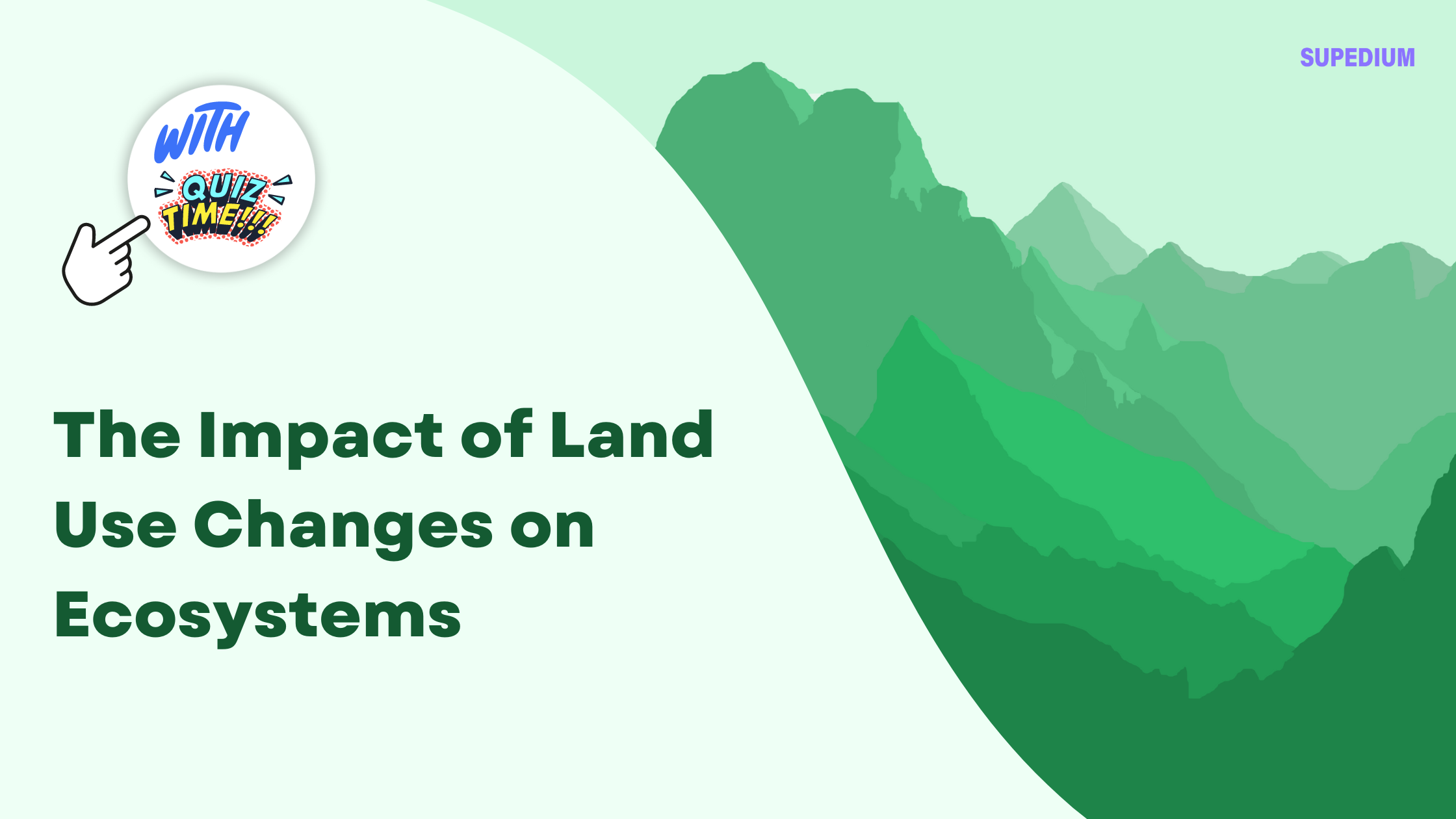Table of Contents
![]()
Introduction
Land use changes refer to the ways in which human activities modify the natural environment. These changes, driven by factors such as urbanization, agriculture, deforestation, and industrialization, have profound effects on ecosystems. Ecosystems, defined as dynamic complexes of plant, animal, and microorganism communities interacting with their non-living environment, play crucial roles in sustaining life on Earth. Understanding the impact of land use changes on these systems is essential due to their implications for biodiversity, ecosystem services, and overall environmental health.
Types of Land Use Changes
Urbanization involves the expansion of cities and towns, resulting in the conversion of natural landscapes into built environments. This process includes infrastructure development such as roads, buildings, and parks, which often leads to habitat loss and fragmentation.
Agriculture transforms natural landscapes into farmland. This conversion may involve clearing forests for crops or livestock, and often includes practices like monoculture and intensive farming. Such changes can degrade soil health and disrupt local ecosystems.
Deforestation is the large-scale removal of forests for purposes such as logging, agriculture, or urban expansion. It results in significant habitat loss and contributes to biodiversity decline.
Industrialization involves establishing industrial zones, mining operations, and other resource extraction activities. This can lead to pollution, habitat destruction, and changes in local climate conditions.
Other land use changes include tourism development and energy production, such as the establishment of wind farms or solar panels, which can also impact ecosystems in various ways.
Impact on Biodiversity
Habitat Loss: The conversion of natural landscapes for human use leads to a reduction in the area available for wildlife. Fragmentation of ecosystems further isolates species populations, making it harder for them to find mates, food, or migrate.
Species Extinction: Habitat loss and fragmentation are primary drivers of species extinction. For example, deforestation in the Amazon rainforest has led to the decline of numerous species, including the jaguar and various primates. Additionally, disrupted migration patterns affect species like monarch butterflies, which rely on specific routes for reproduction.
Changes in Species Composition: Land use changes can lead to the invasion of non-native species, which may outcompete native species and alter food webs. For instance, agricultural expansion can introduce invasive plants that outcompete local flora, affecting herbivores and predators alike.
Case Studies:
- Amazon Rainforest Deforestation: The clearing of the Amazon rainforest for agriculture and logging has led to significant biodiversity loss and altered global climate patterns.
- Coral Reef Degradation: Coastal development and pollution have damaged coral reefs, leading to declines in fish populations and the overall health of marine ecosystems.
Impact on Ecosystem Services
Provisioning Services: Land use changes impact the availability of resources such as food and water. For instance, the conversion of forests to farmland may increase food production but can reduce water quality and availability due to soil erosion and runoff.
Regulating Services: Ecosystems regulate climate, air quality, and soil fertility. Urbanization and deforestation contribute to climate change by increasing greenhouse gas emissions. Agricultural practices can lead to soil degradation and erosion, affecting the natural regulation of nutrients and water.
Supporting Services: Ecosystem processes like nutrient cycling and pollination are essential for maintaining ecosystem health. Changes in land use can disrupt these processes; for example, monoculture farming reduces biodiversity and affects pollination services by diminishing the variety of plants and pollinators.
Cultural Services: Ecosystems also provide recreational and aesthetic benefits. Urban expansion and industrialization can reduce access to natural areas, impacting cultural and recreational activities, as well as the connection between people and nature.
Environmental and Social Consequences
Climate Change: Land use changes contribute to climate change through the release of greenhouse gases from deforestation and industrial activities. This leads to altered climate patterns, affecting weather, sea levels, and biodiversity.
Soil and Water Quality: Agriculture and urban development can lead to soil erosion and pollution of water resources. For example, runoff from agricultural fields can carry fertilizers and pesticides into waterways, affecting aquatic ecosystems and human health.
Human Health: The spread of diseases can be exacerbated by land use changes. For instance, deforestation can increase the risk of zoonotic diseases by bringing humans into closer contact with wildlife. Additionally, changes in land use can impact food security and livelihoods, especially in rural communities dependent on natural resources.
Social and Economic Implications: Land use changes can displace communities and alter local economies. Industrial development may lead to job creation, but it can also result in the loss of traditional lands and cultural practices.
Mitigation and Adaptation Strategies
Sustainable Land Use Planning: Implementing zoning laws and land use policies that prioritize conservation and sustainable practices can help mitigate the negative impacts of land use changes. Green infrastructure and urban planning that incorporate natural systems can reduce environmental impacts.
Conservation Efforts: Establishing protected areas and engaging in ecosystem restoration projects can help preserve biodiversity and restore damaged ecosystems. For example, reforestation efforts in deforested regions can help recover habitat and improve ecosystem functions.
Technological Solutions: Advances in technology, such as precision agriculture, can reduce the environmental footprint of farming practices. Remote sensing and monitoring tools can provide valuable data for managing and protecting ecosystems.
Policy and Advocacy: International agreements, such as the Convention on Biological Diversity, and national policies focused on conservation and sustainable development are crucial for addressing the impacts of land use changes. Advocacy and public awareness campaigns can also play a role in promoting sustainable practices.
Future Directions and Research
Emerging Trends in Land Use: Trends such as urban greening and changes in agricultural practices offer potential solutions to some of the challenges posed by land use changes. Exploring these trends and their effectiveness will be important for future sustainability.
Gaps in Current Knowledge: There is a need for more research on the long-term effects of land use changes and their impact on lesser-known ecosystems. Understanding these dynamics is essential for developing effective conservation strategies.
Call to Action: Addressing the impacts of land use changes requires integrated approaches that consider ecological, social, and economic factors. Public awareness, education, and collaboration across sectors are vital for fostering sustainable land use practices.
Conclusion
Land use changes have significant and wide-ranging impacts on ecosystems, affecting biodiversity, ecosystem services, and human well-being. By understanding these impacts and implementing strategies for mitigation and adaptation, we can work towards a more sustainable future. The challenge lies in balancing human needs with the health and resilience of our natural environments, ensuring that both can thrive together.






Be the first to comment